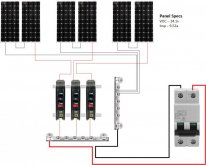Looking for some confirmation that my math is correct. Building a RV system and think I have everything figured out as far as panels, wiring, and MPPT sizing.
I‘m starting with 4 x 200W panels with room to expand to 6 at some point if needed. The RV came pre-wired with 10 AWG from the roof to the garage. Specs on the Renogy panels:
Voc - 24.1 volts
Imp - 9.52 amps
10 AWG wire can handle up to 30 amps. I know you have to account for some loss over distance but honestly not quite sure what the calculation there is. If I configure 2S3P:
24.1v x 2 = 48.2v x 1.2 for temperature compensation (I live in central Alberta so yes, it gets cold!), the maximum voltage is 57.84
9.52 a * 3 = the maximum amperage is 28.56
With this configuration I should be safe with the existing 10 AWG wiring and a 100|50 MPPT. Honestly I was expecting to need a much larger charge controller else I’m missing something?
Now, where I get really confused is the amperage to the batteries from the MPPT does not jive with what the panels are able to produce. 1200 watts of solar could under ideal conditions produce up to 100 amps correct? Would I be leaving too much on the table with this charge controller?
I‘m starting with 4 x 200W panels with room to expand to 6 at some point if needed. The RV came pre-wired with 10 AWG from the roof to the garage. Specs on the Renogy panels:
Voc - 24.1 volts
Imp - 9.52 amps
10 AWG wire can handle up to 30 amps. I know you have to account for some loss over distance but honestly not quite sure what the calculation there is. If I configure 2S3P:
24.1v x 2 = 48.2v x 1.2 for temperature compensation (I live in central Alberta so yes, it gets cold!), the maximum voltage is 57.84
9.52 a * 3 = the maximum amperage is 28.56
With this configuration I should be safe with the existing 10 AWG wiring and a 100|50 MPPT. Honestly I was expecting to need a much larger charge controller else I’m missing something?
Now, where I get really confused is the amperage to the batteries from the MPPT does not jive with what the panels are able to produce. 1200 watts of solar could under ideal conditions produce up to 100 amps correct? Would I be leaving too much on the table with this charge controller?
Last edited:




